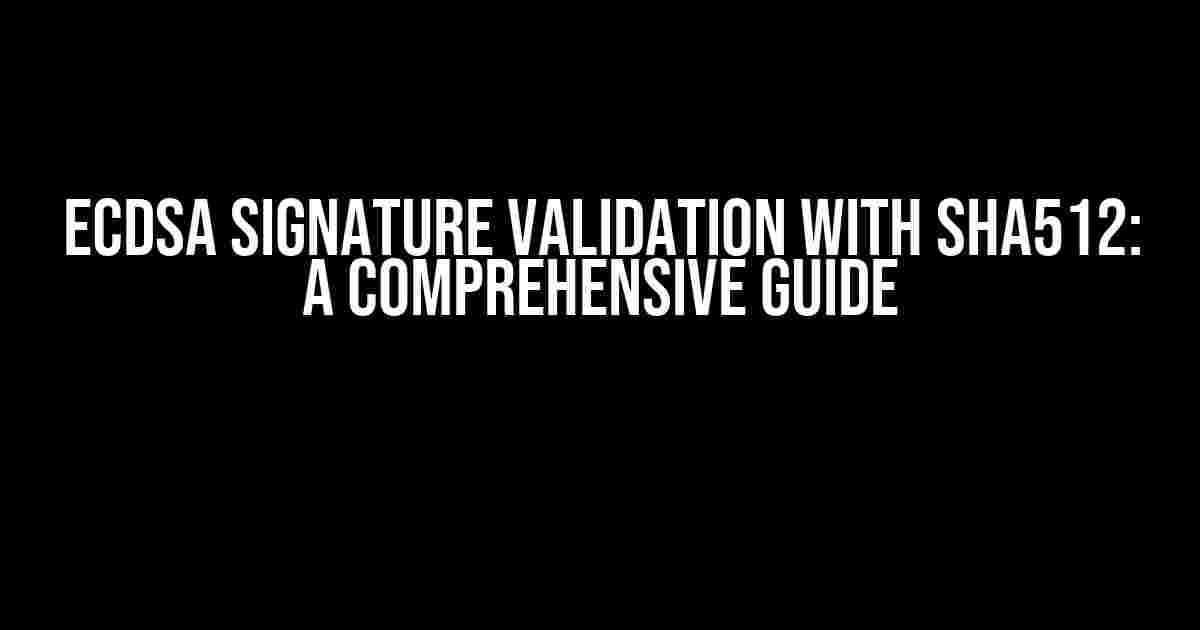Are you struggling to validate ECDsa signatures with SHA512? Worry no more! This article is here to take you by the hand and walk you through the process step-by-step. By the end of this guide, you’ll be an expert in ECDsa signature validation with SHA512.
What is ECDsa and Why Do We Need Signature Validation?
ECDsa, short for Elliptic Curve Digital Signature Algorithm, is a type of digital signature that uses elliptic curve cryptography to ensure data authenticity and integrity. In simple terms, ECDsa is a way to secure data by “signing” it with a secret key. This signature can then be verified by anyone with the corresponding public key.
Signature validation is crucial because it allows us to confirm that the data has not been tampered with during transmission. Without validation, an attacker could intercept the data, alter it, and then re-sign it with their own key, making it seem like the original sender sent the altered data.
What is SHA512 and Why Do We Need it for ECDsa Signature Validation?
SHA512, short for Secure Hash Algorithm 512, is a type of cryptographic hash function that produces a 512-bit (64-byte) hash value. In the context of ECDsa signature validation, SHA512 is used to hash the data before signing it. This is done to ensure that the signature is not vulnerable to preimage attacks.
A preimage attack occurs when an attacker tries to find an input that produces a specific output hash value. By using SHA512, we make it computationally infeasible for an attacker to find an input that produces the same hash value as the original data.
Tools and Prerequisites
Before we dive into the validation process, make sure you have the following tools and prerequisites:
- OpenSSL installed on your system (you can download it from here)
- A basic understanding of command-line interfaces and cryptographic concepts
- A pair of ECDsa keys (private and public) in PEM format
- A piece of data to sign and validate (e.g., a text file)
ECDsa Signature Generation with SHA512
Now that we have our tools and prerequisites in place, let’s generate an ECDsa signature with SHA512. We’ll use OpenSSL to perform the operations.
openssl ec -in private_key.pem -out signature.der -sha512 -data input_data.txtIn this command:
openssl ecspecifies the ECDsa algorithm-in private_key.pemspecifies the input private key file-out signature.derspecifies the output signature file in DER format-sha512specifies the hash algorithm to use (in this case, SHA512)-data input_data.txtspecifies the input data file to sign
Understanding the Output
The output of the above command will be a file named signature.der containing the ECDsa signature in DER format. The signature is a binary file that contains the R and S values, which are used in the validation process.
ECDsa Signature Validation with SHA512
Now that we have our signature, let’s validate it using the public key and the original data.
openssl ec -pubin -in public_key.pem -inform PEM -out /dev/null -sigfile signature.der -data input_data.txt -sha512In this command:
openssl ecspecifies the ECDsa algorithm-pubinspecifies that the input key is a public key-in public_key.pemspecifies the input public key file-inform PEMspecifies the input key format (in this case, PEM)-out /dev/nullspecifies the output file (in this case, we’re not interested in the output, so we redirect it to/dev/null)-sigfile signature.derspecifies the input signature file-data input_data.txtspecifies the input data file to validate-sha512specifies the hash algorithm to use (in this case, SHA512)
Understanding the Output
The output of the above command will be a verification result, which will indicate whether the signature is valid or not. If the signature is valid, OpenSSL will output “Verified OK”. If the signature is invalid, OpenSSL will output an error message.
Common Errors and Troubleshooting
During the signature generation and validation process, you may encounter errors due to various reasons. Here are some common errors and their solutions:
| Error | Solution |
|---|---|
| Error: “unable to load EC private key” | Check that the private key file is in the correct format (PEM) and that the file is not corrupted. |
| Error: “no signature provided” | Check that the signature file is in the correct format (DER) and that it is not empty. |
| Error: “verification failed” | Check that the public key, private key, and input data are correct. Also, ensure that the hash algorithm (SHA512) is correct. |
Conclusion
ECDsa signature validation with SHA512 is a crucial process to ensure data authenticity and integrity. By following the steps outlined in this guide, you should now be able to generate and validate ECDsa signatures with SHA512 using OpenSSL.
Remember to always use secure key management practices to protect your private key, and to verify the signature whenever you receive data from an untrusted source.
Happy coding!
This article is optimized for the keyword “ECDsa Signature Validation With SHA512”. If you have any questions or need further clarification, please leave a comment below.
Frequently Asked Question
Get your doubts cleared about ECDsa signature validation with SHA512!
What is ECDsa signature validation, and how does it work?
ECDsa (Elliptic Curve Digital Signature Algorithm) signature validation is a cryptographic technique that ensures the authenticity and integrity of digital messages. It works by using a private key to generate a digital signature, which is then verified by the recipient using the corresponding public key. The verification process involves hashing the message with a hash function like SHA512, and then checking if the resulting hash matches the one obtained from the digital signature.
Why is SHA512 used in ECDsa signature validation?
SHA512 (Secure Hash Algorithm 512) is used in ECDsa signature validation because of its security and performance benefits. SHA512 produces a 512-bit hash value, which is large enough to prevent hash collisions and ensure the integrity of the message. Additionally, SHA512 is a widely used and trusted hash function, making it a popular choice for cryptographic applications.
How does ECDsa signature validation with SHA512 provide security?
ECDsa signature validation with SHA512 provides security by ensuring the authenticity, integrity, and non-repudiation of digital messages. The use of a private key and a secure hash function like SHA512 makes it computationally infeasible for an attacker to forge a digital signature or alter the message without detection. This ensures that the recipient can trust the authenticity and integrity of the message.
What are the advantages of using ECDsa signature validation with SHA512?
The advantages of using ECDsa signature validation with SHA512 include high security, performance, and flexibility. ECDsa is more efficient than other digital signature algorithms like RSA, and SHA512 provides a high level of collision resistance. Additionally, this combination is widely supported and compatible with various platforms and applications.
Are there any limitations or vulnerabilities in ECDsa signature validation with SHA512?
While ECDsa signature validation with SHA512 is a highly secure technique, there are some limitations and potential vulnerabilities. For example, the security of the algorithm relies on the secrecy of the private key, and the use of a weak or compromised private key can compromise the security of the system. Additionally, quantum computers may potentially be able to break ECDsa in the future, although this is still a topic of ongoing research.


